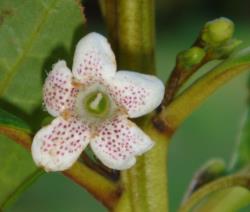- Taxon
- Gallery
Tree up to 14 m tall, trunk up to 500 mm in diam., bark smooth to lightly furrowed and pale brown to cream–brown. Branchlets prominently angled, smooth and usually lacking tubercules, but occasionally weakly tuberculate, glabrous, non-resinous, leaf scars raised. Leaf bud and emerging leaves usually black, resinous. Leaves 70–100 × 25–35 mm, ovate, broadly elliptic, oblong–broadly elliptic to occasionally elliptic, glabrous, discolorous, alternate, coriaceous; secretory cavities obscure, minute, immersed in lamina; base cuneate; margins finely serrate distally, sometimes entire; apex acute to sometimes subacute; abaxial surface with midrib prominently raised. Flowers 17.0–18.5 mm in diam., 1–5 per axil, variable number on same branch; pedicels terete, 3–12 mm long, glabrous. Sepals 5, 1.3–3.0 × 0.7–1.0 mm, narrowly triangular, attenuate, glabrous, apex acute. Corolla bud pale white, open flower white, pink–brown or purple to lavender–purple spotted on lobes and in tube; lobes 4.5–6.5 × 4.0–4.5 mm, apex obtuse to rounded; tube 4.2–4.5 mm long, 3.5–5.5 mm across; outer surface of lobes and tube glabrous; inner surface of lobes and tube with succulent hairs, tube hairs ~ 0.15 mm long, lobe hairs up to 1.0 mm long. Stamens 4; filaments 5.0–5.5 mm long, glabrous, tapered toward apex, exserted, inserted ~ 1/3 from base of corolla tube; anthers 0.9–1.3 × 0.7–0.9 mm, creamy-white. Ovary 3.2–4.8 × 1.8–3.0 mm, green, glabrous, ovoid, 3–5-locular with one ovule per locule; style 2.8–4.0 mm long, white, with pilose patent hairs toward base. Fruit a drupe; exocarp white when immature, becoming purple when mature, drying brown; endocarp 5.0–9.0 × 4.0–5.5 mm, woody, hard, broadly elliptic, elliptic–oblong to ovoid, not compressed, prominently 3–5 angled, apex acute to apiculate, base obtuse; seed 2.8–3.0 × 0.9–1.1 mm, oblong, pale orange–yellow.
[Reproduced from Heenan & de Lange (2011, New Zealand J. Bot. 49: 17–26) with permission from The Royal Society of New Zealand.]




